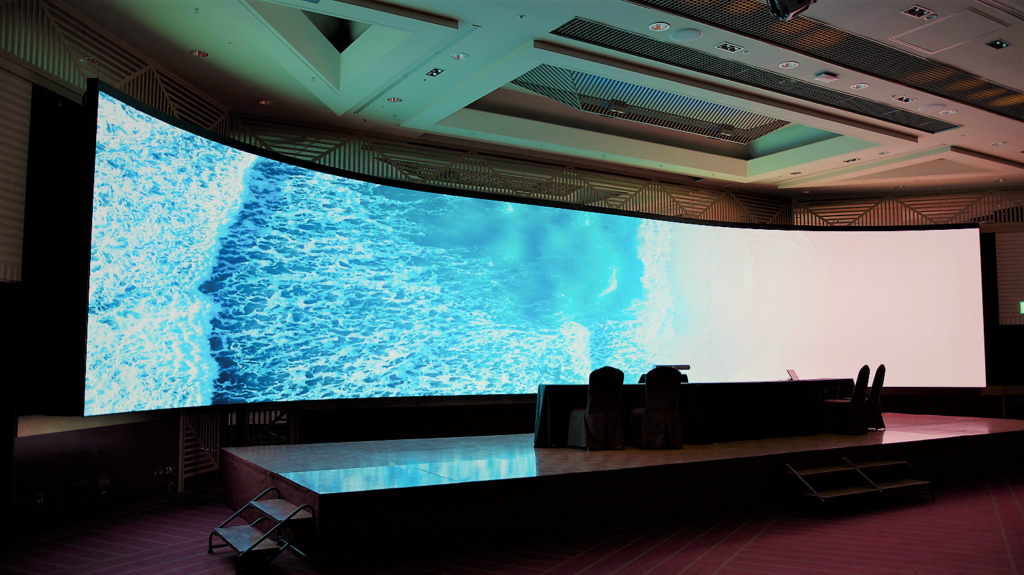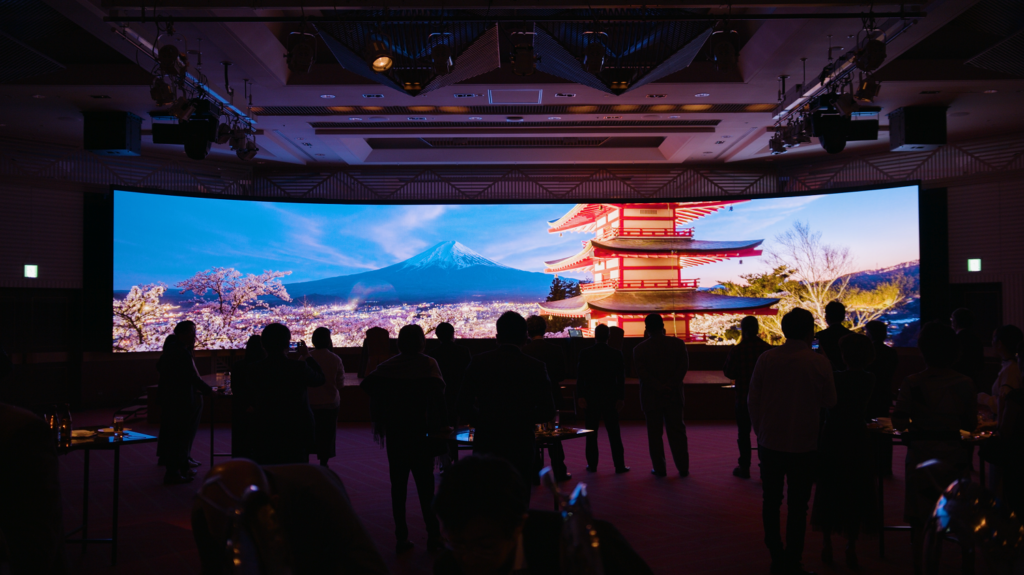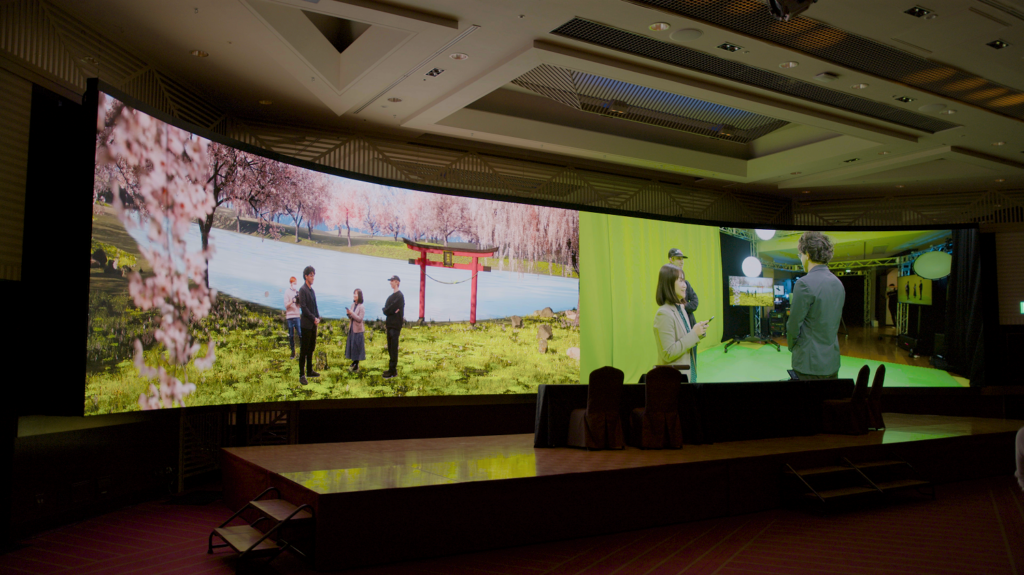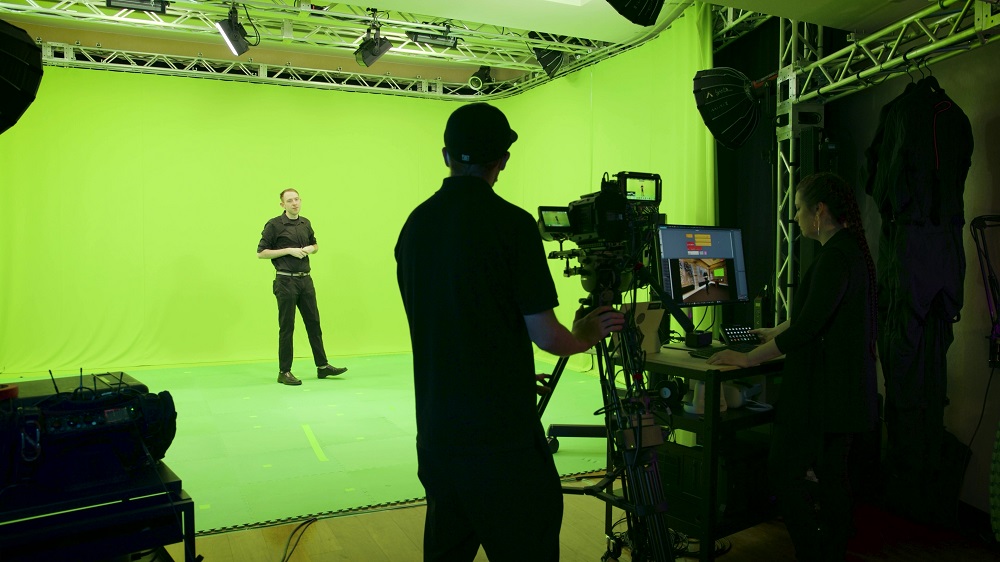
Design and install a one-of-a-kind curved LED wall and a complete virtual production studio, both incorporating premium audio and video equipment and staffed by on-site experts from Vega’s Japan office who can provide pre- and post-production support.
INTRODUCTION
Hilton is a leading global hospitality company with a portfolio of 18 world-class brands comprising 7,000 properties, one of which is Hilton Tokyo. Located in Shinjuku, Japan’s largest entertainment and business district, this 830-room hotel has 2,305 sqm of event space including a 968 sqm event space incorporating the Kiku ballroom and its lobby lounge with a bar counter. With a six-meter ceiling and space for up to 1,200 guests, the ballroom at Hilton Tokyo is the preferred venue for conferences and other large-scale events.
THE ASK
The pandemic has changed the way business events are hosted and attended. With the advent of online and, later, hybrid hosting capabilities, event organizers are enjoying more freedom but experiencing growing pressure to consider event formats that promote greater sustainability and inclusion. Meanwhile, due to pandemic-induced shifts in work-life balance, events are facing more competition and attendees have higher expectations. Hilton Tokyo sought to respond to this new environment by installing technology that could support online, hybrid, and in-person events. The aim was to enhance the ability to host events and gain a distinct advantage in the event-hosting market, improving both event capacity and competitive edge in the industry.
THE ANSWER
Vega conceptualized and created a virtual production studio to support in-person, hybrid, and online business events, and installed a state-of-the-art LED wall. Together, the two would dramatically improve how content is produced, and enjoyed, thereby securing Hilton Tokyo’s position as one of the leading meeting venues in Japan. The studio could be leveraged to live stream, broadcast, and create a pre-recorded video, in either a standalone capacity or alongside the use of other meeting spaces in Hilton Tokyo.
Vega also used its in-depth knowledge of emerging audiovisual technologies to establish an on-site team of experts to support event content creation and delivery. The team’s presence allows content to be conceptualized and brainstormed on the spot, deal with the changing pace of the project, and troubleshoot as needed, to make events smoother for organizers and more engaging for the audience.
CHALLENGES & SOLUTIONS
With such a complex task, requiring many components, the project faced a variety of challenges, both large and small, which Vega and its partners tackled head-on.
Power
The first challenge was how to generate sufficient power for the LED wall. The proposal to draw power from a transformer located on lower floors was deemed unfeasible due to the associated high costs. It was not possible to utilize the power supply of the Kiku ballroom as it was occupied with other events during the installation process. An innovative solution was devised to obtain the necessary power, which involved repurposing the power source of a coffee machine using a transformer. To determine the location of power cables within the ballroom walls, X-ray scans were conducted. Finally, an additional two kilometers of cable was installed, running from the former outlet of the coffee machine to the LED wall.
As with any major change to a property’s electric usage, it was necessary to ensure that installing the LED wall kept the hotel within its electricity limits for the property and the city block. Hilton Tokyo’s engineering team was on hand to support the navigation of the paperwork for the necessary permissions.
Timescale
Due to bookings of the Kiku ballroom, Vega had only two weeks to decommission Hilton Tokyo’s existing system (comprising a projector, a roll-down screen, and glass panels) and install the new system. New components needed to be delivered in time, but pandemic-induced global supply chain disruption and limited availability of the rare earth metals used in electronics made this challenging.
The team built in a longer lead time as a safety net and worked around the booked events by stopping work over certain periods, thereby avoiding disruption. This approach allowed the LED wall to be used successfully for an event on the day after its scheduled completion.

Installation
The initial plan was to install a flat LED wall, but a Vega partner suggested the space would lend itself well to a curved version, which would make displays feel more immersive. A curved LED wall would also allow presenters to stand center-stage without blocking their content, which could be displayed on their right and left.
The engineering team sat down to brainstorm how to create a curved LED wall that would be 15.1 meters wide and 3.04 meters high while being supported with minimal visible structures. It was agreed that the first line of LED panels had to be straight to ensure a clean display, followed by five-degree adjustments at each panel, which each had to be perfectly aligned, to achieve the curved feature.
In parallel, the team designed a custom-built system that had very limited exposed supports or cables, yet was able to take the heavy weight of the panels and the audio speakers. After carrying out a site survey and checking regulations, the team drilled through some concrete walls to run the speaker cables into the control room.
With such intricate tasks, it was vital to communicate minute details among all stakeholders in Japanese and English, so Vega took particular care in translation. The result of everyone’s efforts is an audiovisual system that presents content in a more immersive and engaging way, giving the whole dynamic of the Kiku ballroom a real boost.
Integration
In addition to the dedicated Vega team at Hilton Tokyo to support the use of the LED wall and virtual studio, the hotel’s engineering, technical, and operations teams remain an integral part of event delivery. With this in mind, Vega was eager to consider Hilton Tokyo’s teams as much as possible and develop strong working relationships with them for the project’s mutual success.
Efforts were made to facilitate a gradual, rather than the steep, learning curve for the hotel’s existing teams. Regarding equipment, transitioning from the use of VGA connectors to HDMI or optical connectors, for example, required upgrades: however, it turned out to be a win-win for all because of the increase in overall quality. Integration of the Vega team is continuing, as its members meet with Hilton Tokyo staff weekly to discuss upcoming events and lessons learned as well as what to look forward to in the longer term.
Future-proofing
In light of the rapid advancements in technology, it was paramount to ensure that the LED wall maintained its peak performance for an extended period. LED walls are known to degrade over time, but Vega took proactive measures during installation to future-proof the wall. By operating the wall at a mere 28 percent brightness, it produced crystal-clear imagery with no shadow or blurring even in the presence of ambient lighting. This approach allowed Vega to boost the brightness without compromising image quality when required, thereby guaranteeing the wall’s longevity.
Vega has stockpiled a substantial supply of spare parts on-site that can be readily interchanged in the event of any hardware malfunctions to further ensure the wall’s durability. The system is powered predominantly by high-definition digital technology and is connected to the virtual production studio via eight strands of glass fiber optic cable. This technological setup provides ample flexibility and potent data transmission capacity, enabling resolutions of 8K and beyond. As a result, this future-proof solution can keep pace with expected advances in technology for a significant period.
While reducing the LED wall’s intensity extends its lifespan and safeguards the LED diodes from burnout to Vega, future-proofing means having a system that is ready to accommodate emerging technology as it develops. With its adaptable architecture and cutting-edge capabilities, Vega’s LED wall is poised to remain at the forefront of its field for years to come, while offering a top-notch viewing experience to audiences.

TECHNOLOGY
The LED wall is comprised of 252 LED tiles (W28 x H9), each with a pixel resolution of W6720 x H1215. The screen has a video wall processor & switching system with a configurable operator console and multiple layout options.
Vega selected Barco, a worldwide technology leader that creates networked-based visualization solutions, as the provider of the LED video wall and image processing solution.
Barco’s expansive knowledge and long-standing innovation in the videowall field ensured it was able to fulfill the requirements of a curved LED wall to accentuate the immersive viewing experience. Its Infinipix™ image processor with its reliable and powerful processing ensures superior quality, flexibility, and durability, and allows for widescreen blending and mapping to perfection in any screen configuration.
As a premium global brand with 80-plus years of heritage, Barco readily complies with exacting international event industry standards and offers an unmatched level of in-country customer service, Vega is confident that users will be able to use the equipment immediately once the final configuration is complete, without the need for configuration, while also having easy access to the manufacturer should the need arise.
The audio system is provided by award-winning, patent-protected loudspeaker provider Martin Audio. The investment in this international industry-standard equipment transformed the sound quality in the space.

The virtual production studio, meanwhile, is equipped with the latest game engine software and cinema-grade hardware. It supports XR and non-XR shoots, has a multi-site linkup, and boasts greenscreen capability as well as Dolby Atmos spatial audio recording and mixing capability.
The technology in the studio allows for the realization of a full-production event, which wasn’t previously possible without renting equipment from an outside vendor. It is now possible to create virtual environments, scenic backgrounds, custom content (for example, according to brand guidelines), and video layers to add on top of presentations—all with the support of Vega’s dedicated on-site team if desired.
Vega Japan’s project lead noted: “One of our key differentiators, in particular with the studio, is that we have a creative content team to help clients develop more engaging media so end users can have a more enjoyable experience—that is the future of events.”
